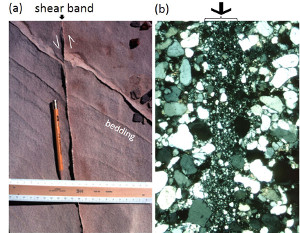| |||||||
|
|
|||||||
|
|
|||||||
| Shear Bands | |||||||
|
Shear bands refer to bands with macroscopic shear offset across them (Figure 1a). Thus, they are also faults by definition. Shear bands are commonly one to a few millimeters thick and are characterized by a central zone of smaller grains (Figure 1b) formed by fracturing of the original grains by a process known as cataclasis. In general, most shear bands have internal heterogeneities and rough boundaries (Aydin, 1978: Torabi et al., 2015) akin to their propagation and growth. Most shear bands have positive relief in the field although shear bands with no relief or even with negative relief also exist. Most shear bands undergo volumetric deformation in addition to shearing. These mixed mode bands are referred to as compactive shear bands if they are involved in volume decrease and dilatant shear bands if they are associated with volume increase in addition to shearing. Although rare, shear bands without any significant volumetric component of deformation also occur judging from the same range of porosity values for some shear bands and the adjacent parent rocks within the accuracy of the measurements (Antonellini et al.,1994). These are called isochoric shear bands (Aydin et al., 2006). The micromechanism of shear bands commonly involves grain motion, pore collapse, and fracturing of constituent grains, resulting in a reduction of grain size and porosity and permeability (Antonellini and Aydin, 1994). These subjects will be revisited under 'Mechanisms and Mechanics of Shear Bands.' However, there are shear bands without any significant degree of grain fracturing. | |||||||
| Types of Shear Bands: | |||||||
| Splay Shear BandsEchelon Shear BandsComposite Shear Bands | |||||||
| Reference: |
|||||||
| Antonellini, M., Aydin, A., Pollard, D.D., 1994 Aydin, A., 1978 Aydin, A., Borja, R., Eichhubl, P., 2006 Torabi, A., Aydin, A., Cilona, A., Jarsto, B.E., Deng, S., 2015 |
|||||||
|
Readme | About Us | Acknowledgement | How to Cite | Terms of Use | Ⓒ Rock Fracture Knowledgebase |
|||||||
